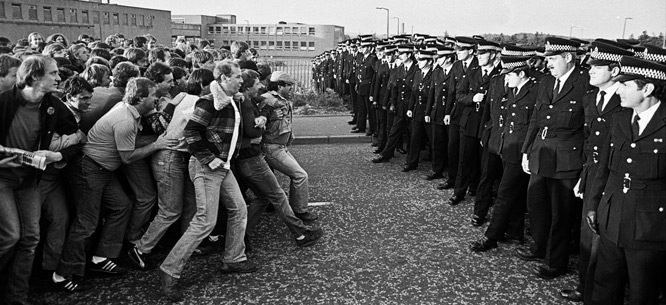General Discussion
Related: Editorials & Other Articles, Issue Forums, Alliance Forums, Region ForumsThe People’s Flag is Palest Pink
from Dissent magazine:
The People’s Flag is Palest Pink
Tim Barker ▪ Winter 2015

[font size="1"]From Still the Enemy Within, about miners’ strikes in 1984-85. Courtesy of John Sturrock.[/font]
Margaret Thatcher died of a stroke on April 8, 2013, at the age of eighty-seven. Her enemies, from the Irish republicans who blew up her hotel bathroom to the rock stars who sang about “Margaret on the Guillotine” and “The Day That Thatcher Dies,” could celebrate at last. But the legacy of her eleven years in power—measured in inequality, decaying trade unions and public institutions, and the Labour Party’s ceaseless retreat from its socialist origins—is as strong as ever.
Today not even the National Health Service, famously unscathed by Thatcher, is safe from privatization. Scotland’s recent near-secession was, at least in part, a desperate attempt to wrench its modest welfare state away from English austerity. Perhaps because we still live in the world Thatcher made, even her death has not completely extinguished the impulse to imagine Thatcher dying. Hilary Mantel’s latest collection is charmingly called The Assassination of Margaret Thatcher, and the counterfactual title story imagines a sniper landing a shot to the Iron Lady’s “glittering helmet of hair.”
It’s now three decades since Thatcher’s protracted but ultimately successful conflict with one of the country’s largest unions, the National Union of Mineworkers (NUM), which ended in March 1985. In an American context, the miners’ defeat is almost always explained as the trans-Atlantic counterpart of the 1981 PATCO strike, Ronald Reagan’s opening shot in the battle against the countervailing power of organized labor. But in its scope, the British experience far exceeded the American. The longest strike in the nation’s history, the miners’ strike lasted just shy of a year and led to over 10,000 arrests. Through months of bitter material deprivation, the number of workers participating never fell below 100,000. The political edge was also sharper. PATCO had endorsed Reagan in 1980, but the NUM boasted a militant rank-and-file and strident left-wing leadership. In 1974, the union brought down Edward Heath’s Conservative government by going out on strike and forcing new elections. And while PATCO had struck over wages and conditions, the miners fought for the preservation of a nationalized industry and the very existence of their pits, dozens of which Thatcher had proposed to shut down.
Given these existential stakes, the miners’ defeat appeared not just episodic but world-historical, the confirmation of historian Eric Hobsbawm’s 1978 warning: “the forward march of labour”—which over a century before had inspired Capital and underwritten Britain’s welfarist and largely nationalized economy—“appears to have come to a halt in this country.” If there was any hope for the left, many argued, it was through alliances with the diffuse cultural currents—feminist, anti-racist, environmental—that had emerged since the 1960s.
The popular 2014 film Pride neatly dramatizes this historical crossroads while suggesting that the contrast between labor and the “new social movements” is too neat a division. Pride tells the story of Lesbians and Gays Support the Miners, an English solidarity group that raised tens of thousands of pounds for hard-hit strikers in the Dulais Valley of South Wales. (Direct fundraising of this sort was crucial since the British government had sequestered the NUM’s assets.) The film focuses on the time the gay activists spend visiting Wales, going beyond financial subsidy to connect personally with the miners. At first the two groups appear to share little but a list of common enemies: “Thatcher, the police, the public, [and] the tabloid press.” But through a mixture of Hollywood bonhomie (an extended dance sequence, numerous pints in the miners’ welfare hall) and brass tacks politics (advice on dealing with police harassment), most characters overcome their initial discomfort to build solidarity that outlives the strike itself. By the end, the Welsh miners take the lead in London’s Pride march to the tune of Billy Bragg’s “There is Power in a Union.” .....................(more)
The complete piece is at: http://www.dissentmagazine.org/article/the-peoples-flag-is-palest-pink